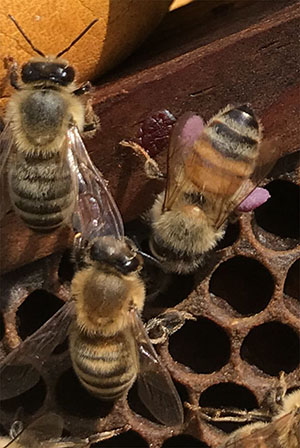
Purple Pollen
One of my girls came home with purple pollen. We have wild artichoke all over our property and the bees love it.
Sincerely,
Juli Tafoya
Dripping Springs, Texas
How Dominant Are We?
Kirk Webster writes: “We dominate the landscape more completely than any other living thing has ever done in the history of the Planet Earth.“ I submit this point of view is erroneous. First, we have no clear evidence of what living things dominated during the 4 billion years before people “took over.” The trilobite was one of the most widespread lifeforms on Earth 270 million years ago, but did it “dominate”? Secondly, the survival of the human species relies entirely upon the natural world. We don’t dominate it at all; we are utterly dependent upon it. Finally, there are countless other species that are as widespread and influential, particularly those that cannot be seen without a microscope. Most of the time, the vast microbial kingdom is simply overlooked. Human health is utterly dependent on it. People have had a significant and lasting impact on the natural world, but we don’t exist independently. Life goes on within us and without us.
Peter L Borst
High-quality Swarm Cells
Hi Eugene,
“Ask a dozen bee keepers and get a dozen different answers” is well known in our circles and I came across a good example of this recently in my reading.
Over breakfast on Monday, 6 May 2019 I read a couple of articles in the November 1981 issue of the ABJ. One “The Gene-Pool Breeding System” I found particularly interesting and I wished that I had studied it back then because I would have been tempted to use the author’s plan.
But then I reached a part where he stated that one should never use swarm cells to raise queens but should crush them and kill the queen as we would be breeding swarm prone bees.
For well over 50 years I have looked on swarm queen cells as being the pick of the bunch and have used them regularly without any noticeable difference in the bees’ inclination to leave home.
So for several hours I had a feeling of disappointment and then I checked the mail box at my gate and found the latest ABJ. So I took a half an hour break and had a quick flip through the pages and, after reading your editorial, I settled on Tina Sebestyen’s “Foolproof Splitting”. And suddenly the sun was shining and the birds were singing because she describes the capped queen cells as “Those are high quality.” How wise are the words of those who write to support the reader’s beliefs!
Two authors, two opinions albeit 39 years apart but read within hours.
Apropos the editorial. I too am diverted by bad spelling and grammar (though not immune myself) so I was comforted to read your comments. In the article about the breeding system in the 1981 ABJ, he refers to the honey in winter should be above the brood so that it is “assessible” to the bees. It suggested, to me, that he was still worried about his tax bill but intended to write “accessible”.
Stan Taylor
Western Australia
Question on “Foolproof Splitting”
To Tina Sebestyen:
In the section “Moving the queen without finding her,” you recommend shaking all the bees into the new colony along with the open brood and leaving the capped brood with the parent colony. If you succeed in moving the queen this way to the new colony, how is the parent colony going to produce a new queen without open brood? Intuitively it seems that if using this technique that you would shake the bees into the new colony along with the capped brood instead, and leaving the open brood in the parent colony. Am I missing something?
Like the tips on timing splits – this year I had a lot of swarming and next year I plan on using the tips to time splits.
Michael Costa
Answer from Tina
Mike,
There are a couple of reasons to move the open brood with the queen, and keep the capped brood in the old colony. One is that ….


